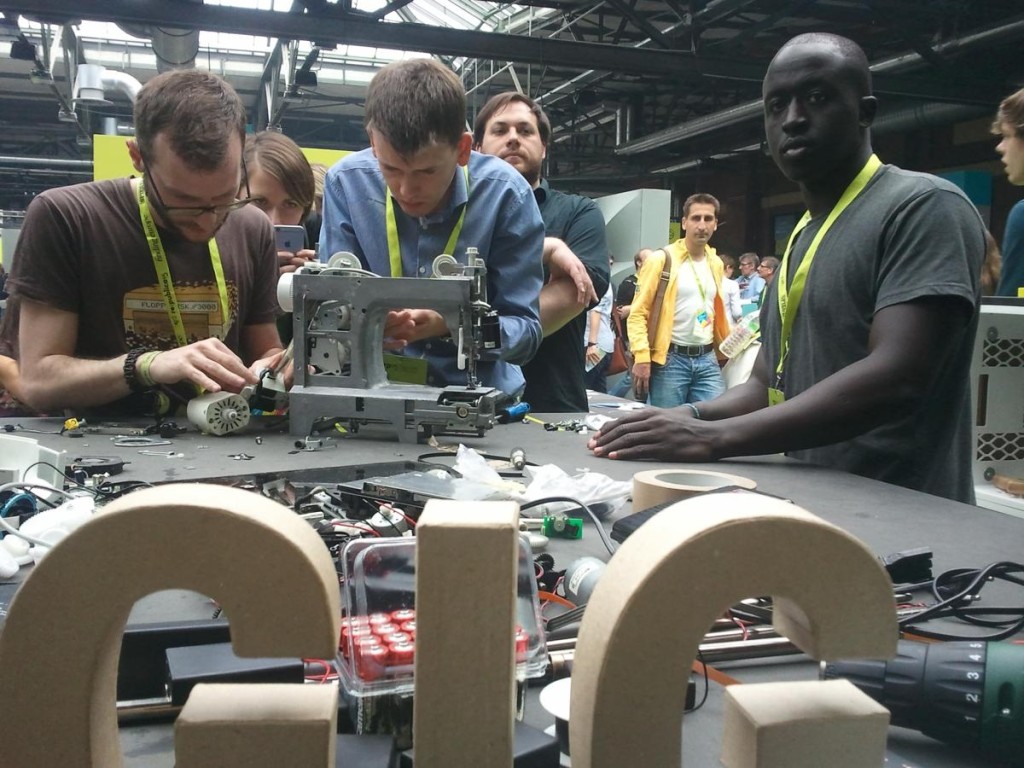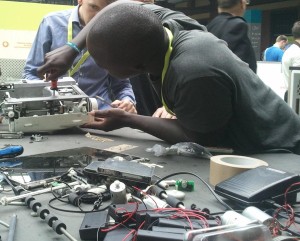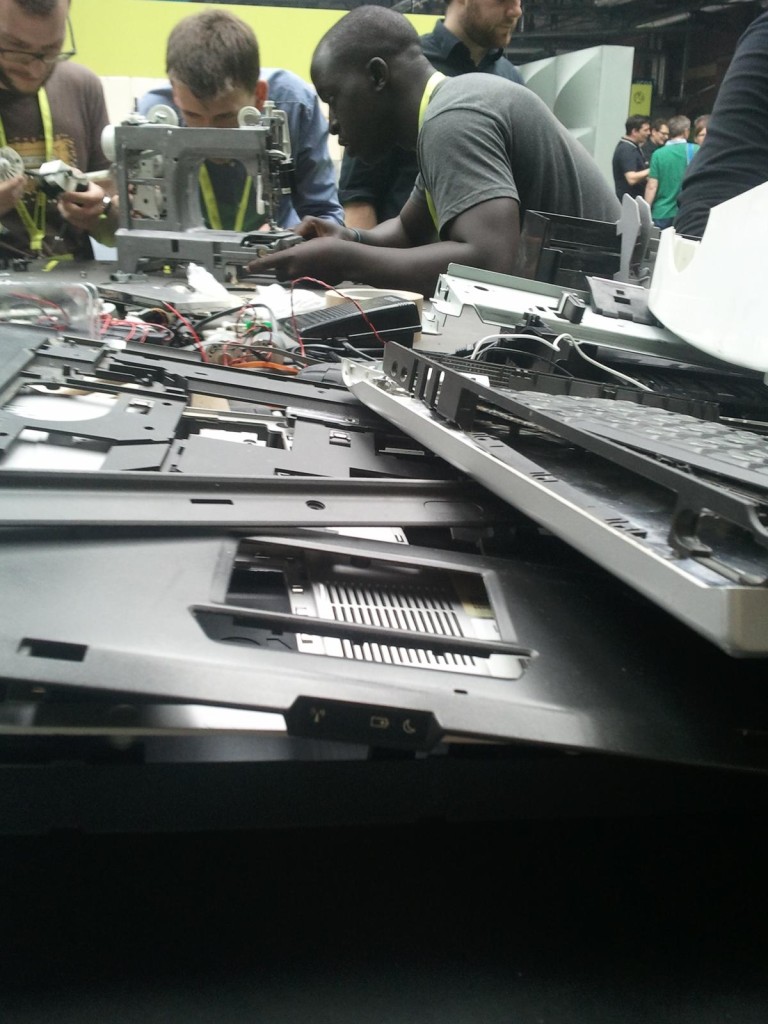Roy Mwangi Ombatti started to tinker with 3D-printing in Nairobi, Kenya more than three years ago. He co-founded and led the Nairobi FabLab Robotics Outreach Program, he produces 3D printers from waste materials, became a Stanford Fablearn Fellow 2014 and he developed a successful low-cost solution to a pressing health problem (his project ‘Happy Feet’ aims at providing bespoke shoes for people with foot deformities as a result of the jigger sand flea in Kenya). I talked to him at re:publica 2015 about his future plans, the role of open source and open innovation and why Africa needs a local 3D printing industry.
_______________
Q: Roy, you just had a workhop on “Motors, Circuits, Value Chains – Building a 3D Printer with E-Waste” here at re:publica 15. Why is it important for Kenya, or for Africa at large to develop such a local 3D printing industry?
Roy: I am passionate about bringing technology to the less fortunate in my country to solve pressing problems. I feel that local self-made technology is the thing that has most impact. For one, it is most easily adaptable to local circumstance, as shows for instance my approach of using available e-waste to build the printer. Also, such self-help in innovation is a perfect tool to promote real change: If you empower people to build their own tools to solve their own problems, you win. In fact, this might be the only way to have sustainable lasting impact.
Q: You are in the last stages of producing a 3D-printer out of locally available electronic waste. When will it be ready?
Roy: I want to finish it within the next three months. Ideally, I will make my first sale in July.
Q: Who will use it?
Roy: For now, I want to generate as much user feedback as possible. Therefore I plan to get it out to maker spaces and fab labs in Nairobi. There I find the people who know how to use it. I know of at least four hardware-related innovation spaces ready to test the printer and more software-related places.
Q: How open source is your endeavor?
Roy: It is very open source from the beginning to the end. The entire process. We conduct training where we teach people how to build their own printers. They can then buy the material from us or source it themselves. We also have an online wiki, where we are trying to document the entire process [URL will follow soon]. Finally, we ask as many people as possible to come and improve or clean up the printing design and manuals. So, if any reader of this wants to join, you are most welcome.
Q: Some folks in Togo are producing a similar printer, are they a competitor or a friend?
Roy: Definitely friends, they are even here at re:publica. We met in Nairobi, their platform is also open source. In fact, they were the ones who inspired me. But in the end we have not really copied what they were doing in terms of printer design. The only thing we both use is the smooth rods, but for instance their frame of their printers is a CPU frame, while we chose another solution, because we are striving to make the printer a nice-looking sellable product that can compete in the market. We also looked at the RepRap Prusa i3 design (open source as well) and then developed our own design.
Q: Does such pan-African or global open sharing really work, or is it more of a dream?
Roy: When we met, we saw that we can learn both ways. Our design is computerized. So we are going to share this design with them. I see a lot of collaboration coming in the future. The “Global Innovation Gathering” at re:publica also got us in touch with Berlin local company called Laydrop with a printer called i3 Berlin. They actually came here three days ago and we got some good ideas – and tomorrow night we will all meet: Togo, Nigeria and Germany. We all have separate markets, so open source sharing is working well for us.
Q: Some weeks ago, you also had a workshop with farmers in Zambia where you worked on getting a local co-creation process going – extending your experimentation beyond D3 printing to general tech design thinking and appropriate tech. “Farmers building their own solutions” – is this a viable solution to the pressing agro-innovation challenges of Africa?
Roy: Definitely. I am of the opinion, that when you want to get a human-centered design, you have to involve the users. Poor people are the experts on poverty. We come in with technical expertise and with design thinking and open source methodologies, and they bring in the problems and simple solutions. Together we hope to come up with revolutionary appropriate tech solutions.
Q: Can you give me an example of a “eureka” moment at the workshop, where such a magic worked?
Roy: At one point, we looked at planting techniques and how labour-intensive they are. Right now the farmer has to dig a hole, check the deepness with his foot, then drop the seed, layer up, then measure the right distance to the next plant, and then move to the next hole. It takes very long for a big piece of land. So, one group of farmers came up with the idea to use a vehicle tire as a planting device. They proposed to put teeth into the tire, so automatically they get the right distance for each hole. I have never seen anything like that but it could be working. And the farmers are automatically in the driver seat. Having them involved since the beginning, makes them understand such a solution and own it. You feel proud.
Q: Did you talk to the farmers about ways to share such a local appropriate tech-solution with other farmers or to get inspiration from others the open-source way?
Roy: One thing I noticed with farmers is that they are very community-oriented. They store their harvest together, they constantly share knowledge. So I think that they would be happy to share, I see no problem with that.
Q: So let me see a problem: In my view, sharing among a local community of trusted members is quite different from global digital sharing. Don’t you think that they would have trouble to relate to an abstract global community?
Roy: I don’t see, why they would refuse, but many situations require local solutions that would perhaps not be so much of interest to others. And you are right that it is also possible that they might want to make money out of their solution at one point. But still I maintain that their communal spirit is very high and might be perfectly in tune with open source style sharing.
Q: How do you envision the future for the maker movement on the African continent?
Roy: I think that the maker movement in Africa has huge potential, even more than in the industrialized world. We have more capacity to grow, we have more young people – and more challenges. But such a positive impact will only happen, if we manage to close the gap between the “fancy maker movement” and the “appropriate tech maker movement” in Africa. Or if something will emerge between the two spaces.
Q: How could that happen?
Roy: People with fab-lab mentality have to come together with local artisan communities and work on something “mixed”. For me such a mix of the new and the old will be able to produce outcomes that are still unimaginable today.
Q: If you had unlimited resources to get to this vision, what would you do?
Roy: I believe in education, so I would do a lot of teaching in practical knowledge. Let’s totally change the curriculum to get people / students acquire one core skill: The skill to get practical change going. I would invest in massive skill imparting through training, teaching and provision of appropriate maker tools. People need to see that they can get active and do not have to stay passive. They need to start feeling that they are in control of their destiny. Then people will start to make amazing things –which we can share with our communities – and with the world.
_______________
Interview & pictures by: Balthas Seibold
License of this interview and the pictures: Attribution-ShareAlike 4.0 International (CC BY-SA 4.0)
Note: This text was first published on the blog of Balthas Seibold at the Alumniportal Germany (www.alumniportal-deutschland.org/en/). Check the blog ( register or login first). All blog entries represent the personal views and ideas of Balthas Seibold.


